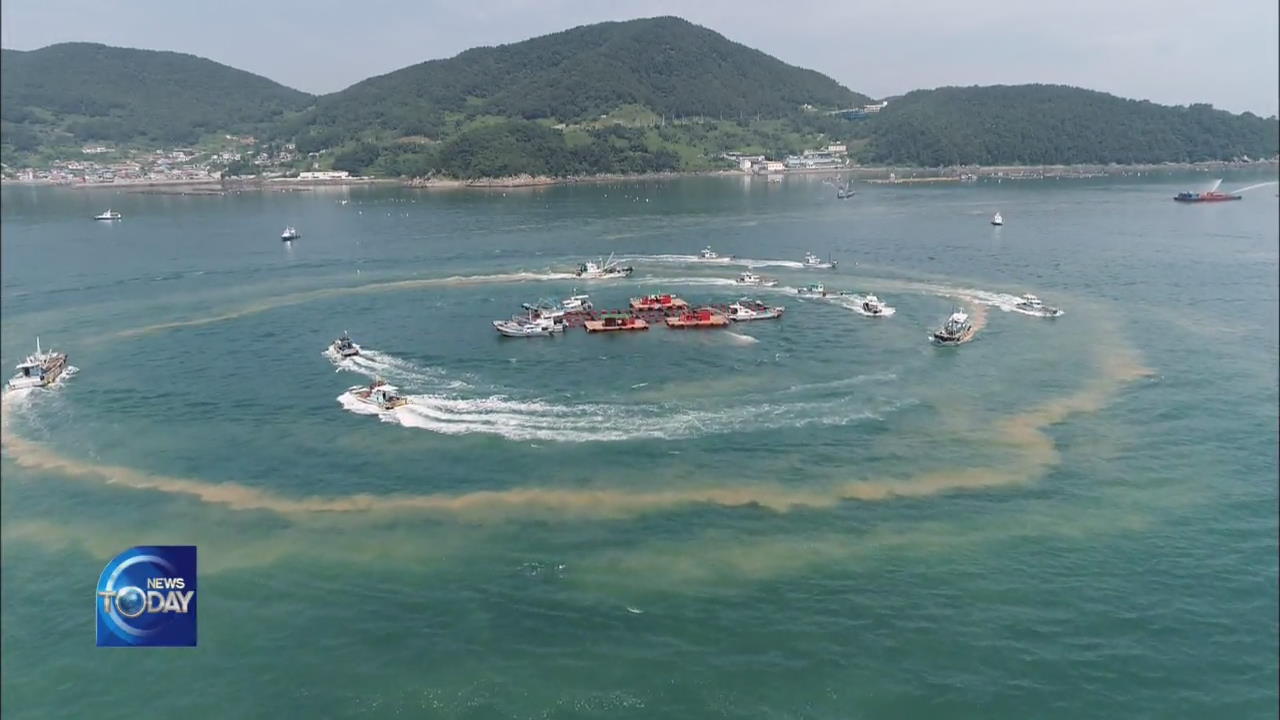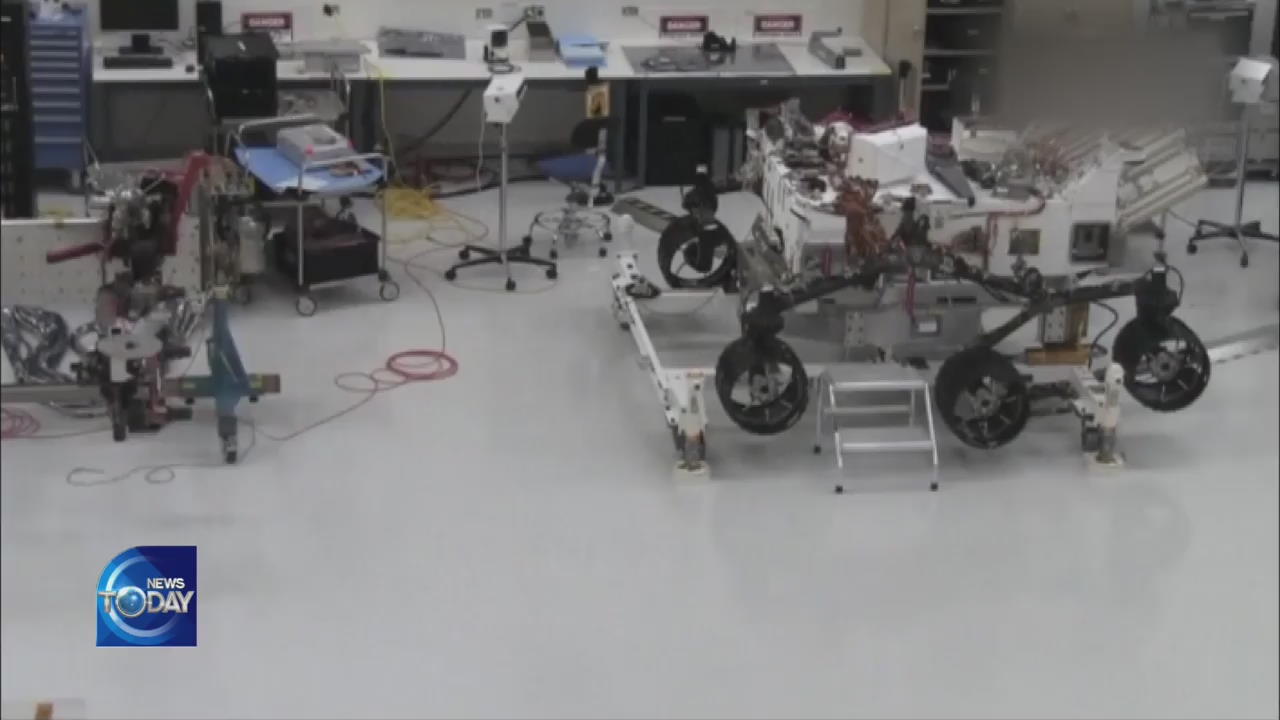DAMAGE FROM RED TIDE ALGAE
입력 2019.09.11 (15:06)
수정 2019.09.11 (16:45)
읽어주기 기능은 크롬기반의
브라우저에서만 사용하실 수 있습니다.
[Anchor Lead]
Damage from red tide algae continues to spread because of the hot weather resulting from the typhoon that hit Korea last weekend. This damage is expected to escalate in the coming days.
[Pkg]
Water mixed with clay sediment is sprayed in the sea off Tongyeong, Gyeongsangnam-do Province. A 50-ton vessel continues sailing in the waters to create waves deep in the sea. It's hoped that this will scatter the algal blooms, at least for a while, by supplying oxygen.
[Soundbite] SONG SANG-WOOK(GYEONGSANGNAM-DO PROV. GOVERNMENT) : "Unlike in previous years, this red tide is occurring low in the sea and cannot be seen with the naked eye. It affects marine cages."
So far, more than 1.8 million fish have died in the southern waters off the Korean Peninsula, resulting in damage amounting to 2.9 billion won. This happened about a week after a red tide alert was issued on September 2. It's the worst damage since 2014, when some 4.7 million fish worth 6.3 billion won died due to red tide algae that lasted more than 80 days. Despite the fishermen's best efforts, the damage continues to snowball.
[Soundbite] LIM JUNG-TAEK(FISH FARMER) : "I thought I would be able to get through this year, but the red tide hit my farm out of the blue just ahead of Chuseok. I don't even want to think about the fact that I could lose my entire herd."
The primary factor behind the rapidly spreading red tide algae is Typhoon Lingling, which hit Korea last weekend. Lingling brought the algae to Korea's coast from far-away ocean waters. Because of the hot weather, the seawater temperature rose to 25 degrees Celsius, creating prime conditions for algal blooms. The government of Gyeongsangnam-do Province is stepping up efforts to minimize damage caused by the red tide. Officials have deployed dozens of vessels to spray water mixed with clay sediment in efforts to contain the spread of the algal blooms. With high-density red tide algae expected to stay in the southern waters for the time being, authorities are urging fish farms to control the amount of feed provided to fish.
Damage from red tide algae continues to spread because of the hot weather resulting from the typhoon that hit Korea last weekend. This damage is expected to escalate in the coming days.
[Pkg]
Water mixed with clay sediment is sprayed in the sea off Tongyeong, Gyeongsangnam-do Province. A 50-ton vessel continues sailing in the waters to create waves deep in the sea. It's hoped that this will scatter the algal blooms, at least for a while, by supplying oxygen.
[Soundbite] SONG SANG-WOOK(GYEONGSANGNAM-DO PROV. GOVERNMENT) : "Unlike in previous years, this red tide is occurring low in the sea and cannot be seen with the naked eye. It affects marine cages."
So far, more than 1.8 million fish have died in the southern waters off the Korean Peninsula, resulting in damage amounting to 2.9 billion won. This happened about a week after a red tide alert was issued on September 2. It's the worst damage since 2014, when some 4.7 million fish worth 6.3 billion won died due to red tide algae that lasted more than 80 days. Despite the fishermen's best efforts, the damage continues to snowball.
[Soundbite] LIM JUNG-TAEK(FISH FARMER) : "I thought I would be able to get through this year, but the red tide hit my farm out of the blue just ahead of Chuseok. I don't even want to think about the fact that I could lose my entire herd."
The primary factor behind the rapidly spreading red tide algae is Typhoon Lingling, which hit Korea last weekend. Lingling brought the algae to Korea's coast from far-away ocean waters. Because of the hot weather, the seawater temperature rose to 25 degrees Celsius, creating prime conditions for algal blooms. The government of Gyeongsangnam-do Province is stepping up efforts to minimize damage caused by the red tide. Officials have deployed dozens of vessels to spray water mixed with clay sediment in efforts to contain the spread of the algal blooms. With high-density red tide algae expected to stay in the southern waters for the time being, authorities are urging fish farms to control the amount of feed provided to fish.
■ 제보하기
▷ 카카오톡 : 'KBS제보' 검색, 채널 추가
▷ 전화 : 02-781-1234, 4444
▷ 이메일 : kbs1234@kbs.co.kr
▷ 유튜브, 네이버, 카카오에서도 KBS뉴스를 구독해주세요!
- DAMAGE FROM RED TIDE ALGAE
-
- 입력 2019-09-11 15:00:32
- 수정2019-09-11 16:45:33

[Anchor Lead]
Damage from red tide algae continues to spread because of the hot weather resulting from the typhoon that hit Korea last weekend. This damage is expected to escalate in the coming days.
[Pkg]
Water mixed with clay sediment is sprayed in the sea off Tongyeong, Gyeongsangnam-do Province. A 50-ton vessel continues sailing in the waters to create waves deep in the sea. It's hoped that this will scatter the algal blooms, at least for a while, by supplying oxygen.
[Soundbite] SONG SANG-WOOK(GYEONGSANGNAM-DO PROV. GOVERNMENT) : "Unlike in previous years, this red tide is occurring low in the sea and cannot be seen with the naked eye. It affects marine cages."
So far, more than 1.8 million fish have died in the southern waters off the Korean Peninsula, resulting in damage amounting to 2.9 billion won. This happened about a week after a red tide alert was issued on September 2. It's the worst damage since 2014, when some 4.7 million fish worth 6.3 billion won died due to red tide algae that lasted more than 80 days. Despite the fishermen's best efforts, the damage continues to snowball.
[Soundbite] LIM JUNG-TAEK(FISH FARMER) : "I thought I would be able to get through this year, but the red tide hit my farm out of the blue just ahead of Chuseok. I don't even want to think about the fact that I could lose my entire herd."
The primary factor behind the rapidly spreading red tide algae is Typhoon Lingling, which hit Korea last weekend. Lingling brought the algae to Korea's coast from far-away ocean waters. Because of the hot weather, the seawater temperature rose to 25 degrees Celsius, creating prime conditions for algal blooms. The government of Gyeongsangnam-do Province is stepping up efforts to minimize damage caused by the red tide. Officials have deployed dozens of vessels to spray water mixed with clay sediment in efforts to contain the spread of the algal blooms. With high-density red tide algae expected to stay in the southern waters for the time being, authorities are urging fish farms to control the amount of feed provided to fish.
Damage from red tide algae continues to spread because of the hot weather resulting from the typhoon that hit Korea last weekend. This damage is expected to escalate in the coming days.
[Pkg]
Water mixed with clay sediment is sprayed in the sea off Tongyeong, Gyeongsangnam-do Province. A 50-ton vessel continues sailing in the waters to create waves deep in the sea. It's hoped that this will scatter the algal blooms, at least for a while, by supplying oxygen.
[Soundbite] SONG SANG-WOOK(GYEONGSANGNAM-DO PROV. GOVERNMENT) : "Unlike in previous years, this red tide is occurring low in the sea and cannot be seen with the naked eye. It affects marine cages."
So far, more than 1.8 million fish have died in the southern waters off the Korean Peninsula, resulting in damage amounting to 2.9 billion won. This happened about a week after a red tide alert was issued on September 2. It's the worst damage since 2014, when some 4.7 million fish worth 6.3 billion won died due to red tide algae that lasted more than 80 days. Despite the fishermen's best efforts, the damage continues to snowball.
[Soundbite] LIM JUNG-TAEK(FISH FARMER) : "I thought I would be able to get through this year, but the red tide hit my farm out of the blue just ahead of Chuseok. I don't even want to think about the fact that I could lose my entire herd."
The primary factor behind the rapidly spreading red tide algae is Typhoon Lingling, which hit Korea last weekend. Lingling brought the algae to Korea's coast from far-away ocean waters. Because of the hot weather, the seawater temperature rose to 25 degrees Celsius, creating prime conditions for algal blooms. The government of Gyeongsangnam-do Province is stepping up efforts to minimize damage caused by the red tide. Officials have deployed dozens of vessels to spray water mixed with clay sediment in efforts to contain the spread of the algal blooms. With high-density red tide algae expected to stay in the southern waters for the time being, authorities are urging fish farms to control the amount of feed provided to fish.
이 기사가 좋으셨다면
-
좋아요
0
-
응원해요
0
-
후속 원해요
0

















이 기사에 대한 의견을 남겨주세요.